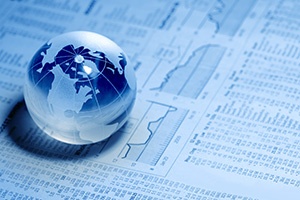 I just got back from 10 days in Iceland with my family. It was a wonderful trip. We saw and hiked waterfalls, glaciers, and volcano craters. We also went on a whale watch, where we got within yards of humpback whales and saw a very rare whale pod (not normally seen in Icelandic waters). As a family, we had a great time—highly recommend!
I just got back from 10 days in Iceland with my family. It was a wonderful trip. We saw and hiked waterfalls, glaciers, and volcano craters. We also went on a whale watch, where we got within yards of humpback whales and saw a very rare whale pod (not normally seen in Icelandic waters). As a family, we had a great time—highly recommend!
As an economist, though, I also had a great time. I mentioned before I left that Iceland had a financial collapse in 2008. I was interested to see, 10 years on, how the recovery was going. In essence, from a tourist’s point of view, 2008 might never have happened. We kind of take that for granted here in the U.S., with markets hitting new highs. But Iceland got hit harder than almost any other country. Good to see it has recovered and prospered—but that is not the only interesting part.
Why everything costs a lot
One of the first things I noted when we got there was the prices. They were crazy expensive—some two to three times higher than Boston, which itself is not cheap. A beer will run you $20, and prices go up from there. I had to turn off the frugal Scottish part of my brain for this trip. Why? Well, the simple reason is that Iceland is a small island, with a small population. It can’t manufacture everything it needs, particularly food, so it has to be imported. Since Iceland is thousands of miles away, that costs a lot, and there are not enough people for efficiencies of scale. Hence, everything costs a lot.
Stepping back a bit, though, there is one big begged question in that set of statements: why can't Iceland manufacture what it needs? Particularly given that, in the past, Iceland did just that because it had to. What’s different this time?
An economy shaped by economic and trade factors
This brings us to the Iceland Industry Museum in Akureyri, up north, and the National Museum of Iceland in Reykjavik. The industrial museum (which was a tough sell for my son, I have to say) has multiple exhibits on different industries, including clothing and printing. All exhibits conclude with the statement that when the economy was opened to imports in the 1960s and 1970s, the Icelandic companies went out of business.
The National Museum has sections on how Denmark, which ruled Iceland at one time, kept it as a captive market and limited trading to Danish companies and ships. Iceland has been shaped over its history by economic and trade factors—2008 was only the most recent iteration.
Parallels with the U.S.
I explained all this to my family, and they were fascinated. More or less. They got a little bit more interested, though, when I pointed out that this scenario is exactly what is happening in the U.S. today. When you look at the reason Icelandic industries shut down in the 1960s and 1970s, it is because they were more expensive than the imports, and buyers preferred cheaper to more expensive. When you look back to the earlier eras, Iceland suffered from trade restrictions by Denmark and by its own government—which is ultimately why those restrictions were removed. The parallels with the U.S., today, are more than clear.
Even more parallels with the U.S. become clear when you look around. Free trade has actually resulted in a much higher standard of living as the economy adapted. Icelanders have fruit to eat, not just fish. They have products, like cars, that could not be economically manufactured in a country that size. They have cheaper clothes. Trade allows them to have better lives, and they have adapted their economy to reflect what they do well, rather than trying to do it all. While there were costs, in the form of lost jobs, the ultimate outcome was better for almost everyone. Once more, there are lessons here for the current U.S. policy debate.
A lesson in free trade
Not sure how much of that got through to my son, but I will keep trying. As an economist, though, what I saw in Iceland was a thriving open economy that depended on free trade. This, in my opinion, bears a lot of resemblance to the U.S.


 Print
Print

